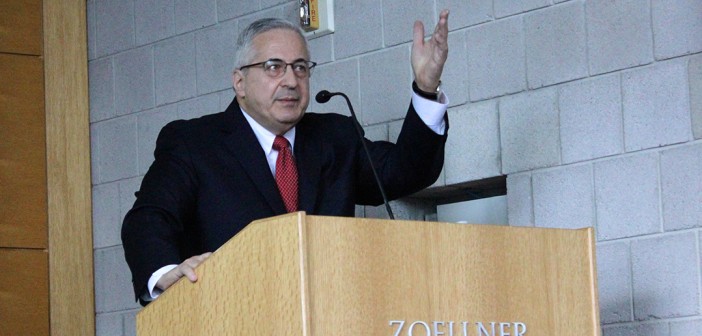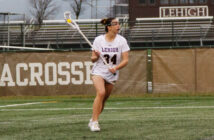One of the founding members of the U.S. Holocaust Museum in Washington, D.C., spoke at Lehigh Thursday afternoon about Nazi looted art.
Dr. Wesley A. Fisher’s presentation, titled “Looted Art: Finding and Returning the Nazi-plundered Art of Europe,” was hosted by the Lehigh University Art Galleries. He was invited to Lehigh’s campus by Alexandria Kennedy ’15, who is majoring in international relations, art history, German, and global studies.
Kennedy’s senior project deals with the globalization of art, specifically focusing on art that has disputed ownership, and how it should be dealt with.
“The event was an extreme success,” Kennedy said. “Dr. Fisher managed to find the fine line between presenting the detailed information of his specialty that would be fascinating to informed people, while keeping the lecture engaging and interesting to a more casual attendee.”
Fisher earned his B.A. at Harvard University and his Ph.D. in sociology from Columbia University—where he later served as a professor for many years. Currently, Fisher is the director of research for the Conference on Jewish Material Claims Against Germany.
The Claims Conference, which was created in 1951, conducts negotiations with the German government in order to provide payments for Holocaust survivors, as well as organizations that serve survivors.
According to their official website, their mission “has always been to secure what (they) consider a small measure of justice for Jewish victims of Nazi Persecution.”
Fisher’s presentation concentrated on what he referred to as “the greatest art theft in history.” Beginning in the early 1930s, Germans started looting pieces of fine art around Germany under the rule of Hitler, who thought of himself as an avid art collector.
Fisher explained that a special task force, known as the Einsatzstab Reichsleiter Rosenberg, was created with the sole purpose of stealing art from the Jewish population living in Paris. The Einsatzstab Reichsleiter Rosenberg expanded its looting territory to many European countries, and it is estimated that the total number of items taken by the Nazi agency is in the millions.
The Allies were able to recover many of the stolen items after the World War II and return them to the countries from which they were taken. However, there are still items that remain unaccounted for today.
Fisher has devoted many years to the international effort of returning stolen pieces of artwork to their original owners.
Fisher explained that in 1998 at the Washington Conference, the Bureau of European and Eurasian Affairs developed a set of non-binding principles to assist in resolving issues related to Nazi-confiscated art. As a result, several countries showed substantial progress in their efforts to return the stolen art—and even putting these principles into law.
Since the mid 1990s, there have been a number of programs to help educate people on the topic of provenance research, which deals with the ownership of historical objects. One of these programs, The Ethical, Legal, and Social Implications research program, is funded and administered by Fisher and the Claims Conference.
“We need to absorb our own ethical principles and understand that care for collections includes ensuring that they are clean collections that do not consist of stolen objects,” Fisher said, “or at least that we know which objects may have been stolen and which have not.”






Comment policy
Comments posted to The Brown and White website are reviewed by a moderator before being approved. Incendiary speech or harassing language, including comments targeted at individuals, may be deemed unacceptable and not published. Spam and other soliciting will also be declined.
The Brown and White also reserves the right to not publish entirely anonymous comments.